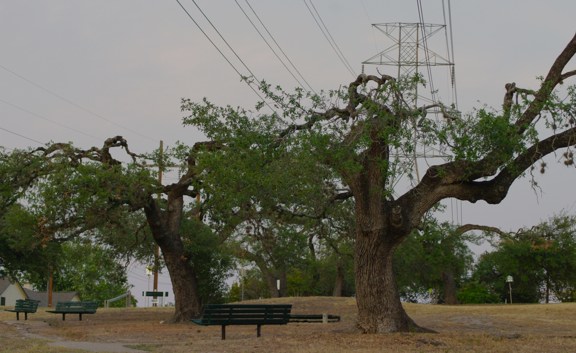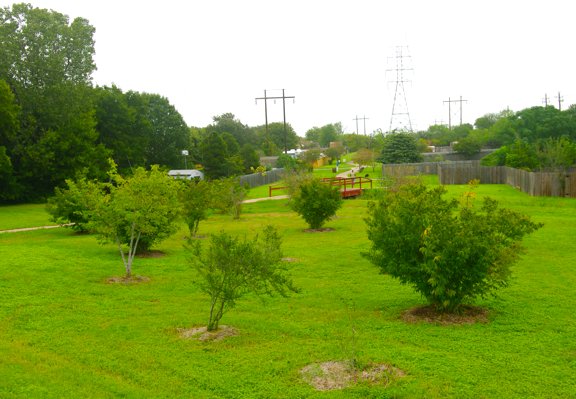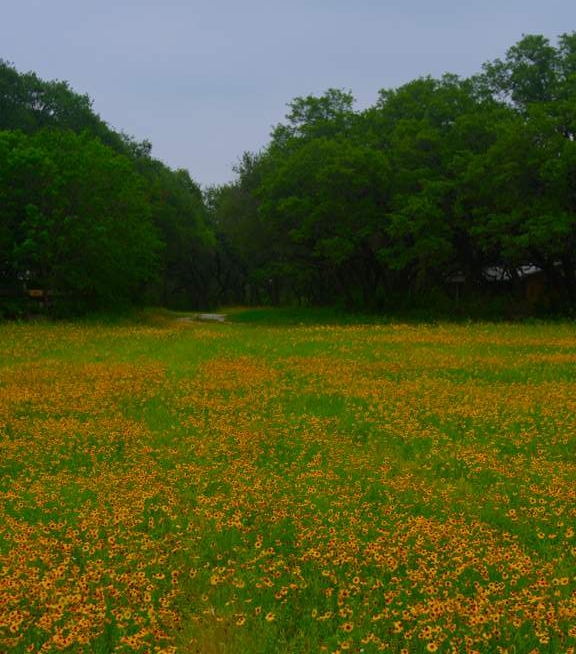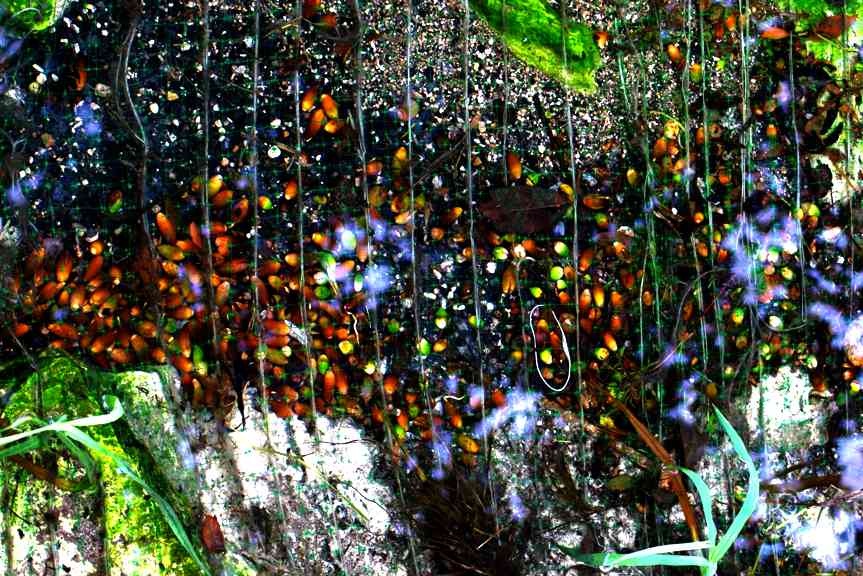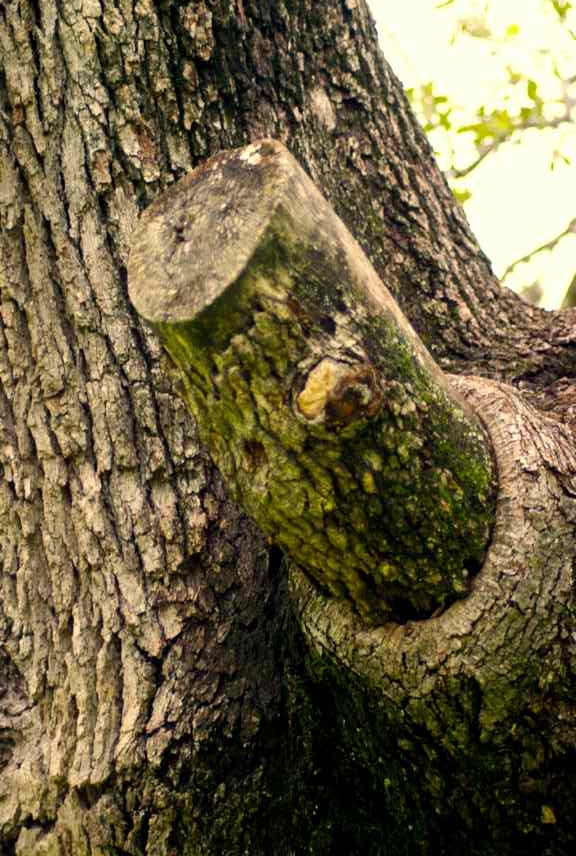We will also once again have a cupcake contest. Bring a batch of patriotic cupcakes and win a prize. Watermelon and lemonade will also be provided, but feel free to bring other items to share.
Thursday, June 24, 2010
Gracywoods celebrates the 4th of July on the 3rd in the Park!
We will also once again have a cupcake contest. Bring a batch of patriotic cupcakes and win a prize. Watermelon and lemonade will also be provided, but feel free to bring other items to share.
Monday, March 1, 2010
LET'S TALK TRASH
- Between 4 and 5 trillion plastic bags are manufactured around the world each year.
- Plastic bags are made from petroleum. It takes about 180 million barrels of oil to make 5 trillion plastic bags.
- Americans throw away approximately 100 billion plastic bags each year.
- It takes 1,000 years for a plastic bag to break down in the environment.
- Approximately 1 billion seabirds and sea mammals die each year by mistakenly ingesting plastic because they think the plastic is food. These animals die a painful death because the plastic usually gets stuck in their intestines or chokes them to death.
Wednesday, October 14, 2009
The Seven Oaks at Swearingen Drive
Boy, did they trim them.
The heat of the summer is actually a good time to trim live oaks if one wants to minimize the spread of oak wilt disease. But any benefit derived from this was quickly negated by the fact that well over 25% (more like 50% to 75%) of the canopy was trimmed from these trees in record heat and dryness. Why were these trees trimmed so harshly? It was in the “agreement.”
The “agreement,” to which I am referring was signed four years ago by a group of interested neighbors and Austin Energy. At that time, due to more stringent federal rules that had recently been enacted concerning the distance tree limbs could be from existing high-tension lines, Austin Energy proposed cutting down all seven of the large oaks that grow in the greenbelt from the edge of Swearingen Drive running down to the west toward the creek. After a prolonged negotiation, it was decided that the oaks would be spared, but trimmed every four years to standards set by Austin Energy.
As it turns out, Austin Energy still wants to cut down the seven live oaks for the same reason that they wanted to four years ago. The decision on whether to cut down the trees or not was never actually made, it was merely kicked down the road for four more years. The four years is now up, and Austin Energy still wants to cut down the oaks. On Monday night, October 5, 2009, at a special meeting of the Gracy Woods Neighborhood Association, it was voted to APPROVE (by a final vote of 14 to 11) the removal of these seven oaks contingent upon approval of the mitigation offered by Austin Energy. I have volunteered to be on the committee that reviews the mitigation.
What is this mitigation? The details have not been decided yet, but it is basically the same kind of mitigation that was done at the Tallowfield end of the greenbelt four years ago when the large trees were cut down from under the power lines there. A number of small, relatively short-lived native (well, mostly native) trees, along with irrigation, were installed.
It should come as no surprise to anyone who has read this blog that I am opposed to the cutting down of large oaks. First and foremost, these oaks provide shade all year around in our greenbelt. The small trees on Tallowfield provide little shade, and none in the winter. Large, established live oaks have the advantage of requiring no irrigation, even in a severe drought, in exchange for year-around shade.
The ages of these Swearingen oaks, when totaled, easily exceed 1,000 years, but that figure does not begin to tell the whole story. The hillside on which they grow is a dry, rocky hillside with little soil. In the past thousand years, thousands and thousands of oaks have attempted to grow on this hillside – oaks of genetically hardy and locally adapted heritage. Of those many thousands of oaks, seven have made it to maturity. The rest were either genetically too weak to survive (this includes tolerance of heat and cold, drought, attacks by pests and pathogens, etc.), germinated in the wrong place to establish a good root system, or were otherwise just plain unlucky. The seven that now stand are the strongest of thousands. There is simply no way that humans can replace them. There is also now no more recruitment of new oaks. The natural process of selecting the strongest to survive has been halted. The constant mowing and other heavy use demanded by our growing human population means there will be no more recruitment of oaks. These oaks are the last.
Gracy Woods is losing its oaks. We have oak wilt in the neighborhood, which is in the process of killing many of our oaks. A number of large oaks were cut down when the new housing development was put in just south and east along Swearingen Drive, around the original Gracy farmhouse. There are also well over 500 live oaks of all sizes on the property about to be developed for a medical facility at the corner of Parkfield and Braker Lane. The preliminary plans that I have seen call for the removal of many of these oaks.
There is no doubt about it – the number of live oaks in Gracy Woods is declining.
Live oaks are excellent for wildlife. Many birds roost in live oaks all year around because the evergreen foliage is good protection from both excessive heat, cold, and all kinds of precipitation. Oaks protect early spring nesting species from our occasional violent storms. Also in the spring, when the new live oak leaves attract lots of moth caterpillars that hang down from the canopy on their long web-like strands of silk, the spring bird migration comes through. Particularly for the most beautiful and fragile of all our spring migrants, the wood warblers (please see my earlier post), these caterpillars help fuel the long journey north. Fewer oaks mean fewer caterpillars, which mean fewer warblers flying through our neighborhood. I find that tragic news, indeed.
And don’t forget the acorns - lots and lots of acorns! This fall bonanza provides food for all kinds of wildlife, including some you wouldn’t normally think about. Below is a picture of one of our creeks after a recent rainstorm, filled with acorns that also feed an aquatic chain of life.
So why would Austin Energy want to cut these oaks down? At the end of the day, I believe that it's all about money. The City of Austin used to have its own tree crews, but those crews have been cut back. Most tree-trimming is now contracted out, which is only cost-effective if it is not done too often. Austin Energy wants to trim the greenbelt only once every four years. In order to keep the trees from growing too close to the high tension lines in four years, according to the Austin Energy arborist, the cutting needs to be extreme, as demonstrated by their recent actions. And sooner or later, with such extreme cutting, the oaks may die. So we might as well cut them down now, and Austin Energy will pay for the mitigation, or so the logic goes.
Is this a self-fulfilling prophecy?
I believe that the oaks could be trimmed more often (say, once every one or two years) and not as harshly, in which case they would certainly look much better. They could be permitted to grow a little taller, and continue to shade the greenbelt, providing habitat for wildlife. But Austin Energy will not grant us that option because it is too expensive.
Our neighborhood is being offered two options as a one-time deal: A planting of smaller trees (with irrigation) in exchange for our support for the cutting of the seven oaks, or continued extreme trimming once every four years. If we choose the latter, there will be no mitigation offered again if the oaks do not survive this kind of trimming. One of the aspects about this agreement that worries me is that once the installation is completed, Austin Energy turns the landscape management over to the Austin Parks and Recreation Department (PARD). Austin Energy is a profitable enterprise; PARD is the one city department that most frequently seems to have its budget cut. Neither of these options sounds like a good deal to me.
There is a principle I learned years ago in college: Think globally and act locally. Globally, rising carbon dioxide levels threaten our weather patterns. At least 20% of rising carbon dioxide levels is caused by deforestation. Large trees absorb carbon dioxide, store it in their trunks as a component of wood for as long as they stand, and release oxygen and water as a result of the process of photosynthesis. This process also helps forest canopies reduce heat, even in city environments. Partly as a result of climate change and partly as a result of habitat loss, over one quarter of all bird species are in decline, including many warblers. So if we are to think globally and act locally, it seems to me that we should be willing to put a little time, energy, and money into trying to save the seven Swearingen oaks instead of cutting them down.
What do you think?
Update: for now, the seven oaks of Swearingen Drive will remain standing, because the special committee appointed by the GWNA to decide whether to approve the proposed mitigation plan or not did not approve of the plan. Going forward, however, the GWNA would like to come up with a more desireable alternative to the serious trimming that these oaks currently endure every four years, so we have set up a new committee to search for a more lasting solution. Please feel free to provide your input!
Monday, May 4, 2009
A Visitor in my Pecan Tree
There is a whole family of small, easily-overlooked woodland birds called Wood-Warblers (family Parulidae) that would probably never attract much attention except for the fact that, in spring plumage, the males are nothing short of magnificent in colorful patterns that rival the most beautiful of tropical birds. In spring, these small birds migrate north rapidly to their summer breeding grounds, eating constantly in the tops of large trees. They eat bugs, and lots of them. They eat millions of caterpillars that would otherwise denude the forests, and help keep the numbers of thousands of insect pests in balance with the amount of vegetation that the forest can easily supply. And because human activity has destroyed (and continues to destroy) so much of the once great eastern American forests, the also dwindling Wood-Warblers must migrate up a thin and disjunct chain of woodland running up the east coast, directly through the parks of New York City.
I remember seeing, in the treetops of New York City, Blue-winged Warblers, Nashville Warblers, Northern Parula Warblers, Chestnut-sided Warblers, Cape May Warblers, Magnolia Warblers, Black-and-white Warblers, Black-throated Blue Warblers, Cerulean Warblers, Blackburnian Warblers, Black-throated Green Warblers, Hooded Warblers, Bay-breasted Warblers, Yellow Warblers… sometimes as many as ten different species in the top of one tree at the same time, none of them over six inches long from beak to tail! It was so intense, that in the spring, all avid birdwatchers complained of a painful malady called “warbler neck.” This migration was one of those things that would be impossible to imagine – the color, the activity, the song, the sheer exuberance of tiny LIFE on the wing in the tops of giant trees, and it left so deep an impression that it has become a part of who I am.
Well, in Austin, the warbler migration is MUCH more subdued. I usually manage to see a Yellow Warbler or two each spring in our neighborhood parks. This spring was no exception:
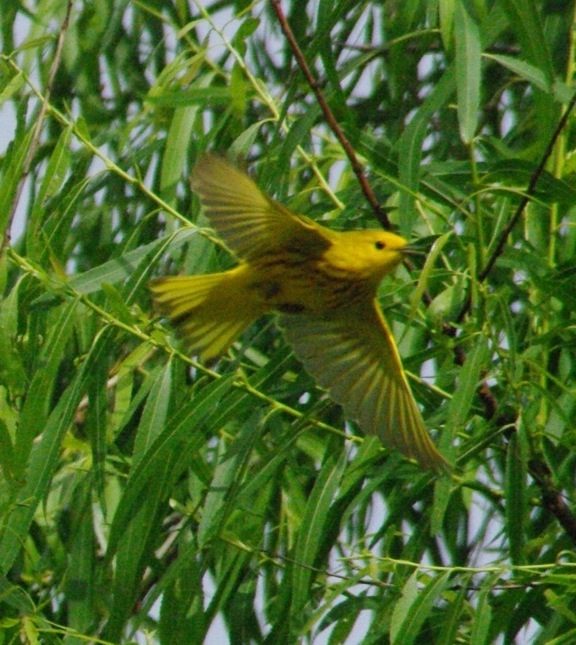
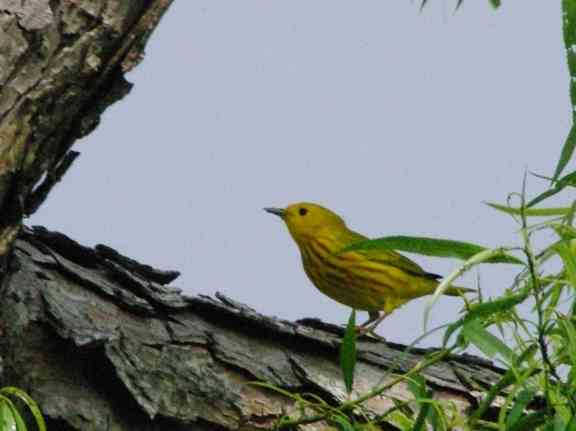
We do have a Wood-Warbler that winters here, the Yellow-rumped Warbler, which is relatively common near water in the colder months. By this time of year, the Yellow-rumped Warbler has left for points north. Unfortunately, the Wood-Warbler migration in Austin doesn’t come close to the one in New York City.
But there is a wonderful exception to this – the Hill Country of Central Texas is the only breeding ground to a beautiful, rare and controversy-creating Wood-Warbler known as the Golden-cheeked Warbler. This bird in an endangered species, which means that the Federal Government has the legal authority to control land use to an extent to protect designated critical habitat, and this is where it gets controversial. Golden-cheeked warblers will only use the long curls of bark from a mature Ashe juniper (“cedar” to most of us) to build its nest, so limiting the cutting of mature “cedar” trees was one of the recommendations made to save the bird from extinction - this was, of course, very unpopular with many landowners. The Balcones Canyonlands National Wildlife Refuge in the City of Austin is one of the areas established specifically for the Golden-cheeked Warbler. Unfortunately, the conservation efforts taken so far to stem the tide of the Golden-cheeked Warbler’s demise have not yet been sufficient, as the warbler’s numbers are still declining. There are probably less than 21,000 birds now in existence.
Will the people of Central Texas modify their land-use policies enough to save the Golden-cheeked Warbler? Only time will tell.
For now, the Golden-cheeked warbler still hangs on in Central Texas. As a matter of fact, a beautiful male (and possibly some of his offspring) visited our neighborhood on Thursday, April 30th. Specifically, he visited the large pecan tree in my front yard, at about 6 PM. I watched (and photographed) him for about 45 minutes as he danced around the pecan canopy, snatching a bug here, gulping a caterpillar there, flashing his beautiful yellow, black, and white pattern for Austin to see. He reminded me, once again, that we have been given an incredibly beautiful world in which to live, but it is as fragile as it is precious. We need to act wisely so that we don’t destroy it.
For those who missed his visit, here are some photographs (click to enlarge):



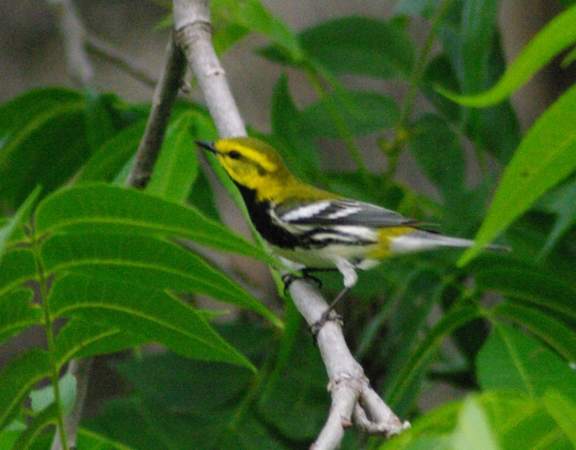
Monday, March 9, 2009
The History of the Gracywoods Guineafowl
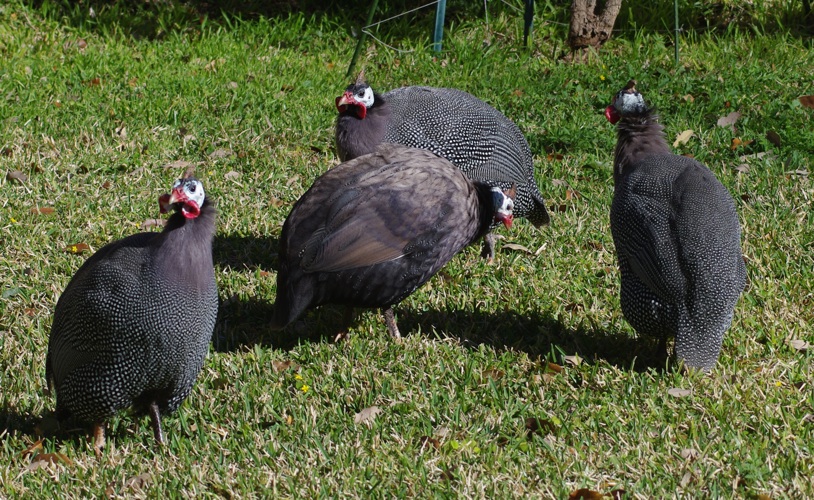
A walk down Swearingen Drive between Parkfield and Carshalton on a pleasant spring day will usually reveal a very unusual sight, at least for an Austin neighborhood – a flock of nineteen rather large, teardrop-shaped birds, gray with tiny white spots, with single, brown horns on their bare, white heads and red wattles on their cheeks, running around on the ground and making odd sounds. Those of us possessing a familiarity with old southern farms might recognize them as Guineahens, or more simply, Guineas. Being an avid birder, I noticed them with surprise the first time I drove down Swearingen Drive in 1992. What were these birds doing in an Austin neighborhood?
Guineafowl (or, more properly, the Helmeted Guineafowl, scientific name Numidea meleagris) are native to Africa south of the Sahara Desert. The name “Meleagris” is actually the old Greek word for Guineafowl, as these African birds were well know to the ancient Greeks, and have been a popular menu item ever since, particularly in southern Europe. As with many birds that humans have found good to eat, Guineas have been widely introduced into other areas of the world, particularly southern France and the West Indies. So when the Spanish explorers of the new world first encountered American turkeys, they originally called them “Meleagris,” mistaking them for Guineafowl.
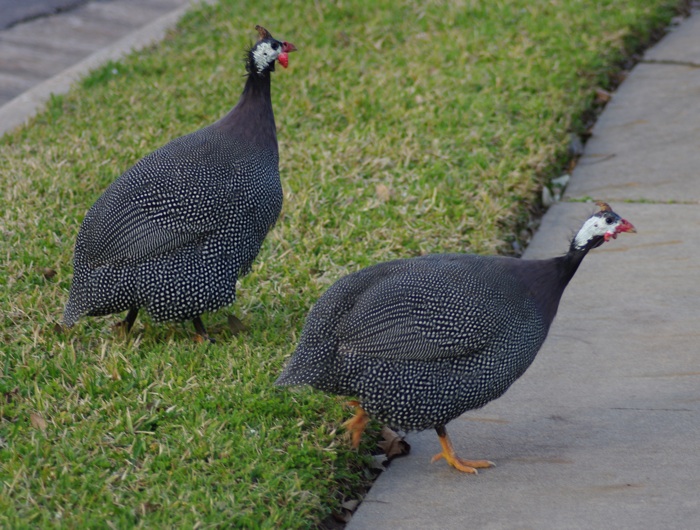
How did these birds end up in a twenty-first century neighborhood in north Austin? To answer that, we need to delve into a little bit of the history of Gracywoods.
In the 1940’s, what is now north Austin was a collection of dairy farms located on the westernmost extensions of blackland prairie just east of the Balcones fault, the geological formation that marks the eastern edge of the Texas hill country. Gracywoods is located on what used to be the old Gracy Farm. About a mile to the south was the Kramer Farm. In the 1940’s, the Kramer Farm had a flock of Guineafowl.
One night in the 1940’s, a strong thunderstorm blew some of the Kramer Guineas up to the Gracy Farm. After the soggy and disoriented birds dried out and had a look around, these displaced Guineas decided they liked the old oaks on what is now Swearingen Drive. This location has remained their home ever since as the city of Austin grew up around them. Who owns these Gracywoods Guineas? The truth is that no one has owned this flock of birds since they left the Kramer farm. The flock has become what is called “naturalized.” But these rather comical-looking birds have made some friends, first with the Gracy family, and later with some of the neighbors of Gracywoods, who have advocated that they remain a part of the neighborhood.

The Gracywoods Guineas roost every night in the branches of one of the live oaks along Swearingen, where they are protected from predators on the ground as well as from rain, wind, and cold. Early every morning, they set off to roam the neighborhood, eating both plant and animal material, including many insects that are damaging to lawns and gardens. They are particularly fond of ticks and June bug larva.
Guineas are always found in flocks. In Africa, where there are an abundance of fierce predators, the flock’s multiple eyes, warning cackles, and large numbers help protect them from the many dangers. They are particularly good at driving away snakes; in Africa, this includes large cobras! In Gracywoods, raccoons sometimes try to snatch a Guinea off an oak limb at night, in which case the Guineas raise a ruckus and the raccoon usually leaves hungry. On particularly dark winter nights, Great Horned Owls might attempt to procure a Guinea feast, but adult Guineas are usually a little too feisty for them. The only ground predator that has much of a chance at catching an adult Guinea would be a large, fast dog. In the City of Austin, dogs are required by law to be restrained (on a leash or behind a fence) at all times, and since dogs are very poor at climbing trees, successful dog attacks on the Guineas are rare. And while they would rather run away, in a pinch, Guineas can still fly pretty well.

Currently there are about 19 Guineas in the Gracywoods flock. Every spring, one or more of the females will lay up to twenty eggs, usually in one nest. The young chicks are mobile at birth, but due to the many predators of young chicks (hawks, owls, snakes, cats, and foxes), few survive to become adults.
From time to time, some of our neighbors have complained about the Guineas. It is true that they may dig a bit in a garden or a yard. They do eat some types of plants, and they can be a little noisy at times. If they roost in an oak that happens to be over a car, there is the inevitable bird mess that can be a nuisance.
A number of years ago, some of these complaints resulted in a decision by the city government that stated that, although the birds were not native, they were essentially “wild,” thus earning the protection of the Austin City statute that protects all wild birds. Because of this, the new “Enclave at Gracywoods” development that has been built on the last remaining wild land around the old Gracy farmhouse, and as a consequence, the last wild Guinea habitat, has actually used the Gracywoods Guineas as a selling point to entice new homeowners.
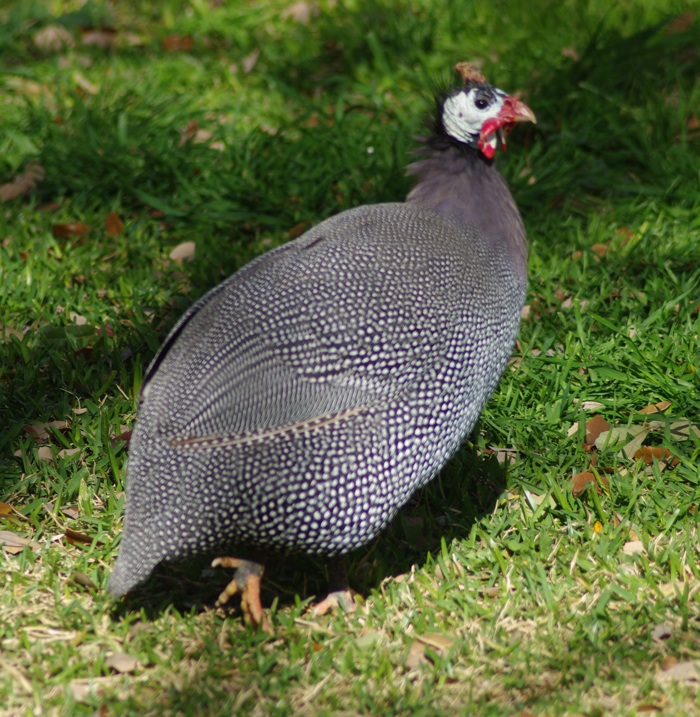
The Guineas have their positive points, also. While there are no longer any venomous snakes in Gracywoods, we do have Lindheimer’s rat snake in our neighborhood. These snakes can get rather large (over five feet long), but they are harmless and can actually be quite beneficial as they eat mostly rats and mice. Nevertheless, many of our residents do not like snakes, and that includes the Guineas, who will drive away any and every snake they find, if they don’t eat it first. And as mentioned earlier, Guineas eat lots of insects, including ticks. And they do help to keep Gracywoods at least a little bit “weird,” or, more accurately, interesting.
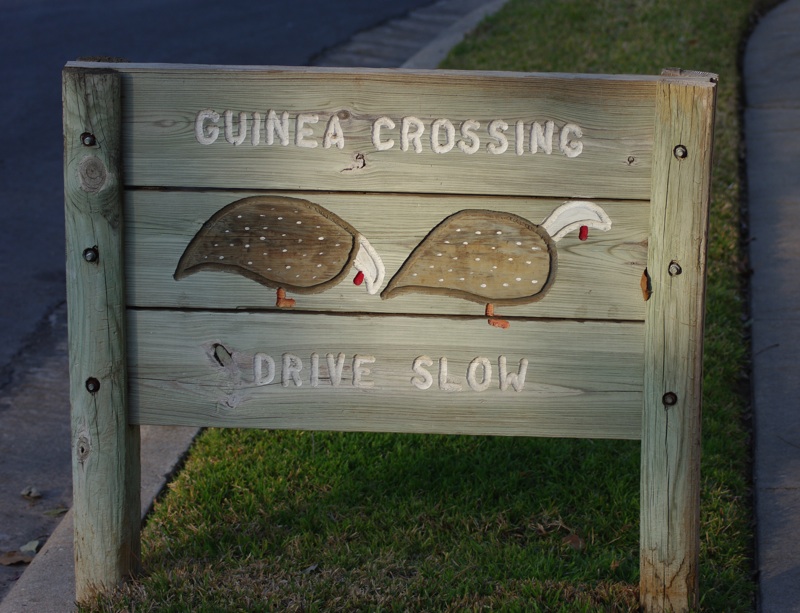
As a whole, the neighborhood supports the presence of the Guineas, and they are a particular favorite of children and families out for a Sunday walk. They even have a special “no speeding” sign of their own, which appears to have helped slow traffic down on Swearingen Drive. Can Guineas and humans live together in an Austin neighborhood? They’ve been doing it now for almost thirty years!


























